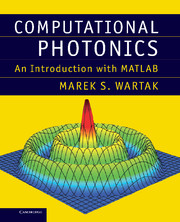Book contents
- Frontmatter
- Contents
- Preface
- 1 Introduction
- 2 Basic facts about optics
- 3 Basic facts from electromagnetism
- 4 Slab waveguides
- 5 Linear optical fibre and signal degradation
- 6 Propagation of linear pulses
- 7 Optical sources
- 8 Optical amplifiers and EDFA
- 9 Semiconductor optical amplifiers (SOA)
- 10 Optical receivers
- 11 Finite difference time domain (FDTD) formulation
- 12 Beam propagation method (BPM)
- 13 Some wavelength division multiplexing (WDM) devices
- 14 Optical link
- 15 Optical solitons
- 16 Solar cells
- 17 Metamaterials
- Appendix A Basic MATLAB
- Appendix B Summary of basic numerical methods
- Index
17 - Metamaterials
Published online by Cambridge University Press: 05 July 2013
- Frontmatter
- Contents
- Preface
- 1 Introduction
- 2 Basic facts about optics
- 3 Basic facts from electromagnetism
- 4 Slab waveguides
- 5 Linear optical fibre and signal degradation
- 6 Propagation of linear pulses
- 7 Optical sources
- 8 Optical amplifiers and EDFA
- 9 Semiconductor optical amplifiers (SOA)
- 10 Optical receivers
- 11 Finite difference time domain (FDTD) formulation
- 12 Beam propagation method (BPM)
- 13 Some wavelength division multiplexing (WDM) devices
- 14 Optical link
- 15 Optical solitons
- 16 Solar cells
- 17 Metamaterials
- Appendix A Basic MATLAB
- Appendix B Summary of basic numerical methods
- Index
Summary
In this chapter we review the basic concept of metamaterials as those possessing simultaneously negative permittivity and permeability over the same frequency range. Theoretical principles and basic experimental results are reviewed. Possible applications including cloaking, slow light and optical black holes are described.
Introduction
Metamaterials are artificially created structures with predefined electromagnetic properties. They are fabricated from identical elements (atoms) which form one-, two- or three-dimensional structures. They resemble natural solid state structures. Metamaterials typically form a periodic arrangement of artificial elements designed to achieve new properties usually not seen in Nature [1]. In a sense, they are composed of elements in the same way as matter consists of atoms.
Metamaterials are characterized and defined by their response to electromagnetic wave. Optical properties of such materials are determined by an effective permittivity εeff and permeability μeff valid on a length scale greater than the size of the constituent units. In order to introduce such a description, one requires that the size of artificial inclusions characterized by d be much smaller than wavelength λ, i.e. d ≪ λ.
The name meta originates from Greek, μϵτα and means ‘beyond’. Main characteristics of metamaterials (MM) are:
• man-made,
• have properties not found in Nature,
• have rationally designed properties,
• are constructed by placing inclusions at desired locations.
With modern fabrication techniques it is possible to create structures which are much smaller than the wavelength of visible light.
- Type
- Chapter
- Information
- Computational PhotonicsAn Introduction with MATLAB, pp. 384 - 405Publisher: Cambridge University PressPrint publication year: 2013



